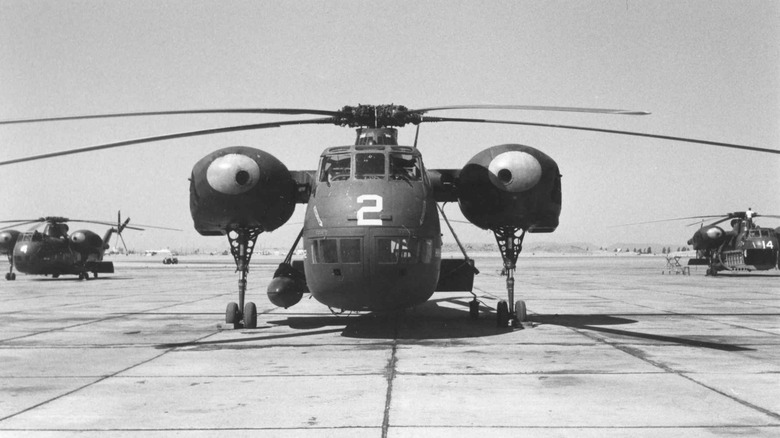Why The CH-37 Mojave Is Considered One Of The US Military's Worst Helicopters
The CH-37 Mojave is a helicopter with multiple designations and an unusual appearance that only a mother could love. Built by the Sikorsky Aircraft Division of United Aircraft Corporation, it was initially known as the S-56, with a design based on the U. S. Navy's 1950 requirement for a Class HR (Assault) Helicopter. The Marines and Navy got the HR2S-1 version, while the Army received the CH-37 (or H-37A) Mojave. It was often called "The Deuce" because of the two very pronounced engine nacelles that extended out from the fuselage; troops went so far as to paint white circles on the front to make them look like eyes.
These pods housed both the fuel tanks and the retractable landing gear, which stretched so far down to the ground that it gave the impression of long, stork-like legs. This configuration, however, allowed the main cargo area (accessed via clamshell nose doors at the front) to hold two jeeps, or one jeep pulling a 105 mm howitzer, and as many as 26 fully equipped marines.
While that sounds impressive, the CH-37's unloaded weight was a hefty 20,831 pounds, thanks in part to the 1,900-horsepower Pratt & Whitney R-2800-54 piston engines, each of which weighed 2,360 pounds. Its gross payload capacity was 31,000 pounds, so it only had about 10,000 pounds to work with, and that didn't take into account the fuel, which further reduced its actual payload capacity. This small payload is one of the reasons it's often considered one of the worst military helicopters of all time.
The CH-37 had googly eyes and lacked power
When the Korean War broke out in June 1950, helicopters were still a relatively new style of aircraft. Igor Sikorsky's R-4, the world's first production helicopter, had only entered production in 1943, before becoming the U.S. Army Air Force's first service helicopter and seeing combat in May 1944. The Korean War was the first time choppers were used extensively in transporting both troops and equipment to the battlefield.
For years after its first flight in 1953, the Mojave was the largest non-Soviet rotary-wing aircraft. It was also the first production helicopter with five main rotor blades, retractable landing gear, auto stabilization, and a folding tail boom that allowed it to be stored in tight areas aboard a ship. Despite all that, the Pratt & Whitneys only had a power-to-weight ratio of 0.89 and were already nearing the end of their lifecycle when they were installed into the Mojave and its variants.
The engines were weak enough that the Commandant of the Marine Corps at the time had issues with the CH-37's travel distance and hovering capabilities. Furthermore, helicopters with far more powerful turboshaft engines — like Sikorsky's own CH-54 Tarhe, which Sikorsky started testing in 1959, and Boeing's CH-47 Chinooks, which began development in 1958 – were soon to replace the CH-37 and its aging engines. Only 55 of the original 150 planned were actually produced.
